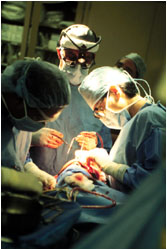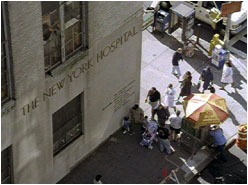Follow NOVA producer Linda Garmon's remarkable journey into head trauma—from the complexities of
capturing a real-life medical drama on film, to the experience of going on-call with renowned
neurosurgeon Dr. Jamshid Ghajar, to the in-depth story of one young boy's fight to live.
The Journey Begins | Dear Film Crew: Help! | On Call | Alex's Case
Tuesday, July 9, 1996
Amtrak Train From Boston to New York City
Passing Through Long Island City
I like to sit on the left side of the train from Boston to New York, so
that when the train gets close to Manhattan, I can watch for my favorite
factory sign: "Easyloading Swingline Staplers." I have delighted in this
 sweeping combination of metal and neon on numerous trips to New York, but
it's not until this precise moment, because of the documentary I am
considering making, that I realize my personal link to the sign.
sweeping combination of metal and neon on numerous trips to New York, but
it's not until this precise moment, because of the documentary I am
considering making, that I realize my personal link to the sign.
I am en route from Boston to New York, in hopes of beginning a new project
for the PBS science series NOVA. Specifically, I am about to meet a
neurosurgeon who helped save the life of a young woman beaten into a coma
and nearly to death in New York's Central Park. There are three intriguing
aspects of this doctor's approach to treating head injury: It's easy and
low-tech, it seems to work—and most hospitals choose not to use it.
But whether we proceed with the project is still an open question. There
are enormous questions of access: Will hospitals allow us onto wards where
the most critically ill are being treated? Will family members allow us to
film tragic and intimate moments of their lives? If we do go forward, it
will surely involve some unusual production arrangements, so bosses in the
home office have requested I keep a running account—the making of "COMA."
Here goes.
In the ten years I have been making films for WGBH, home to NOVA, I have
never been interested in doing a medical documentary. Until now. On the
train, I am re-reading an excellent piece in THE NEW YORKER, "Conquering
the Coma," by Malcolm Gladwell, which is about the Central Park case. This
is what had compelled me to pick up the phone and call Dr. Ghajar to
arrange a meeting.
On the phone, in our first conversation, I had asked Dr. Ghajar whether
head trauma is a big public health problem. I soon learned that it is the
number one cause of death and injury in the age group 1 to 44. "If you
think about it," Dr. Ghajar had said, "you probably know someone who's had
head trauma."
Indeed I did. When I was in the second grade, I went flying off of my
backyard swing and landed smack on the back of my head—with a rather
powerful thud. Dazed and confused, I didn't recognize certain family
members and was taken by my frightened parents to a doctor.
In the wee hours of the next morning, I awoke in a hospital bed, having no
idea what had happened.
The best part of the whole incident was my Swingline Stapler. I was
confined to my bed for two weeks after leaving the hospital, and my mother
buzzed in and out of my room, assuming the roles of doctor, nurse, physical
therapist and schoolteacher. She set up a little "office" on a bed tray,
to help me keep up with schoolwork; one of the supplies was a
stapler—easy-loading, as advertised. I adored it.
Now, as I pass the Swingline Stapler factory sign, I think about my own
experience with head injury. It was a concussion, not a serious blow.
Nonetheless, I would never be able to remember the hours—and even
days—leading up to the accident. How could this be? How could the brain
go backwards in time and block out what happened before the moment of
impact?
As the train winds its way into Penn Station, I am minutes away from
beginning an unbelievable journey into head trauma—one that will answer
the question of my own experience, as well as take me on an emotional
adventure that I could not even begin to imagine.
Wednesday, July 17, 1996
Dr. Jam Ghajar's Office, Aitken Neuroscience Center
Upper East Side, Manhattan, New York
The most frequently asked question of documentary producers is how do you
choose topics? The answer: We look for good storylines; good, articulate
characters; and good visuals. A well-made program should leave the viewers
feeling as if they had been side-by-side with the participants,
experiencing the actual events with them.
To meet this goal for a program on head trauma, it was clear that we
couldn't rely on a bunch of laboratory shots and lots of narration.
 Instead, we needed to capture an unfolding coma case, managed by Dr.
Ghajar, from the moment it arrived in the emergency room. We needed to
bring to the viewers a case that unfolded right before the cameras. But
this presented a host of questions to answer: How could we know when such a
case would start to unfold? Where should we post ourselves—and when? How
long would it take a typical coma case to unfold, and could the average
budget for a NOVA do the story justice? I had walked away from my first
meeting in New York on the COMA project with about two thousand truly
convincing reasons not to proceed.
Instead, we needed to capture an unfolding coma case, managed by Dr.
Ghajar, from the moment it arrived in the emergency room. We needed to
bring to the viewers a case that unfolded right before the cameras. But
this presented a host of questions to answer: How could we know when such a
case would start to unfold? Where should we post ourselves—and when? How
long would it take a typical coma case to unfold, and could the average
budget for a NOVA do the story justice? I had walked away from my first
meeting in New York on the COMA project with about two thousand truly
convincing reasons not to proceed.
But there was one undeniable reason to go forward—and that was Jam Ghajar.
"The art of medicine—I hate that phrase!" he said in our first meeting.
"Doctors use that phrase to mystify the profession and keep it at arm's
length from patients." Medicine should be based on the best scientific
evidence available, not on expert opinion, he explained. Treatment should
include basic, repeatable steps that can be performed in small and big
hospitals, rural and city areas.
Dr. Ghajar, and a handful of his colleagues around the world, had set out to
standardize the treatment of head trauma, which is surprisingly variable
and sometimes detrimental. And I had the opportunity to witness the
revolution. It was hard to resist.
And so now, I find myself back in New York, trying quickly to mobilize
production. Dr. Ghajar hands me a beeper. He now is "on call," available to
manage severe head trauma cases, 24 hours a day. This is a good
opportunity for me to witness the critical steps of a head trauma case;
it's an on call rehearsal.
This is what I learn: First, once the film crew comes on board, we can't
simply trail Dr. Ghajar, or we'll miss the critical first hour or so of the
case. In the emergency room, the trauma team first focuses on basic
resuscitation—"the abc's," for airway, breathing and circulation—before
it can assess the extent of head injury. Then, the patient is taken for a
CT scan, a special x-ray, of the head, the first inside look of what's
happening inside the head. These are all-important steps—but they occur
before the neurosurgeon comes onto the scene.
Instead of following Dr. Ghajar as he is called onto a case, we would need to
camp out in the e.r. to begin covering a case before the neurosurgeon would
even know about it.
But there's another complicating factor—he could be called onto cases at
one of two hospitals—Jamaica Hospital in Queens, and New York Hospital in
Manhattan, separated by a 20 to 40-minute drive, depending on traffic.
This would be no problem if we could hire two film crews, camping out at
each hospital, waiting for a case. But a quick back-of-the envelope
calculation gave me the stark budget choice: We could afford two film crews
if we went on-call for just one 10-day period of time; but it was entirely
 possible there would be no severe head trauma cases during this period.
Alternatively, we could staff up with one film crew and go on call two
different 10-day periods; but it was entirely possible that with just one
crew, camped out at one hospital, we could miss a case unfolding at the
other hospital.
possible there would be no severe head trauma cases during this period.
Alternatively, we could staff up with one film crew and go on call two
different 10-day periods; but it was entirely possible that with just one
crew, camped out at one hospital, we could miss a case unfolding at the
other hospital.
As I am mulling over the best strategy for filming, Dr. Ghajar is paged by
Jamaica Hospital to treat a construction worker who had fallen off a
ladder. At New York Hospital, he checks in on a young boy, who had been
riding his bicycle and had been hit by a car. Both patients went into a
coma after the accidents. In both cases, when Dr. Ghajar was called, he
inserted a tube into the center of the patient's brain to drain fluid to
relieve pressure.
The first few days of these cases is life and death, as the medical team
goes through a tense period of monitoring and intervention to keep the
brain from suffering irreversible damage as the brain swells in response to
the violent trauma.
Watching Dr. Ghajar's patients at various stages in their recovery is
compelling. It reaffirms my commitment to documenting an unfolding case
from the moment it arrives in the e.r.
August 18, 1996
Late at night, home in Cambridge, Massachusetts
It's just about four days before we are due to staff up and start production
on COMA. I had initially decided to position the crew at Jamaica Hospital,
where Dr. Ghajar receives more cases. But I'm shifting strategy at the last
minute.
What if we can cover both Jamaica and New York Hospitals by splitting up
one crew? What if we have two skinny crews, rather than two full crews?
The primary cameraperson, Tom Hurwitz, could be stationed with the primary
sound person, Peter Miller, at Jamaica Hospital—the likelier place that a
case will begin. But the assistant cameraperson, Jeffrey Victor, who also
can serve as a second cameraperson, can be stationed with another sound
person and myself at New York Hospital. If one or the other team gets
beeped onto a case, the two teams can come together.
The trick now is to see whether team members will buy into this new plan.
They would have good reason to be wary. The new scheme more than doubles
each person's workload and responsibilities. If we thin our resources to
camp out at two locations, each team member will have responsibility to be
his or her own producer, director, researcher, fixer, technician, assistant
and so on.
I bang out a letter to the crew members, outlining the new plan. With just
days to go, it's essential that I get their support.
The Journey Begins | Dear Film Crew: Help! | On Call | Alex's Case
Photos: (1,3) NOVA/WGBH Educational Foundation; (2) Aaron Strong.

 sweeping combination of metal and neon on numerous trips to New York, but
it's not until this precise moment, because of the documentary I am
considering making, that I realize my personal link to the sign.
sweeping combination of metal and neon on numerous trips to New York, but
it's not until this precise moment, because of the documentary I am
considering making, that I realize my personal link to the sign.
 Instead, we needed to capture an unfolding coma case, managed by Dr.
Ghajar, from the moment it arrived in the emergency room. We needed to
bring to the viewers a case that unfolded right before the cameras. But
this presented a host of questions to answer: How could we know when such a
case would start to unfold? Where should we post ourselves—and when? How
long would it take a typical coma case to unfold, and could the average
budget for a NOVA do the story justice? I had walked away from my first
meeting in New York on the COMA project with about two thousand truly
convincing reasons not to proceed.
Instead, we needed to capture an unfolding coma case, managed by Dr.
Ghajar, from the moment it arrived in the emergency room. We needed to
bring to the viewers a case that unfolded right before the cameras. But
this presented a host of questions to answer: How could we know when such a
case would start to unfold? Where should we post ourselves—and when? How
long would it take a typical coma case to unfold, and could the average
budget for a NOVA do the story justice? I had walked away from my first
meeting in New York on the COMA project with about two thousand truly
convincing reasons not to proceed.
 possible there would be no severe head trauma cases during this period.
Alternatively, we could staff up with one film crew and go on call two
different 10-day periods; but it was entirely possible that with just one
crew, camped out at one hospital, we could miss a case unfolding at the
other hospital.
possible there would be no severe head trauma cases during this period.
Alternatively, we could staff up with one film crew and go on call two
different 10-day periods; but it was entirely possible that with just one
crew, camped out at one hospital, we could miss a case unfolding at the
other hospital.